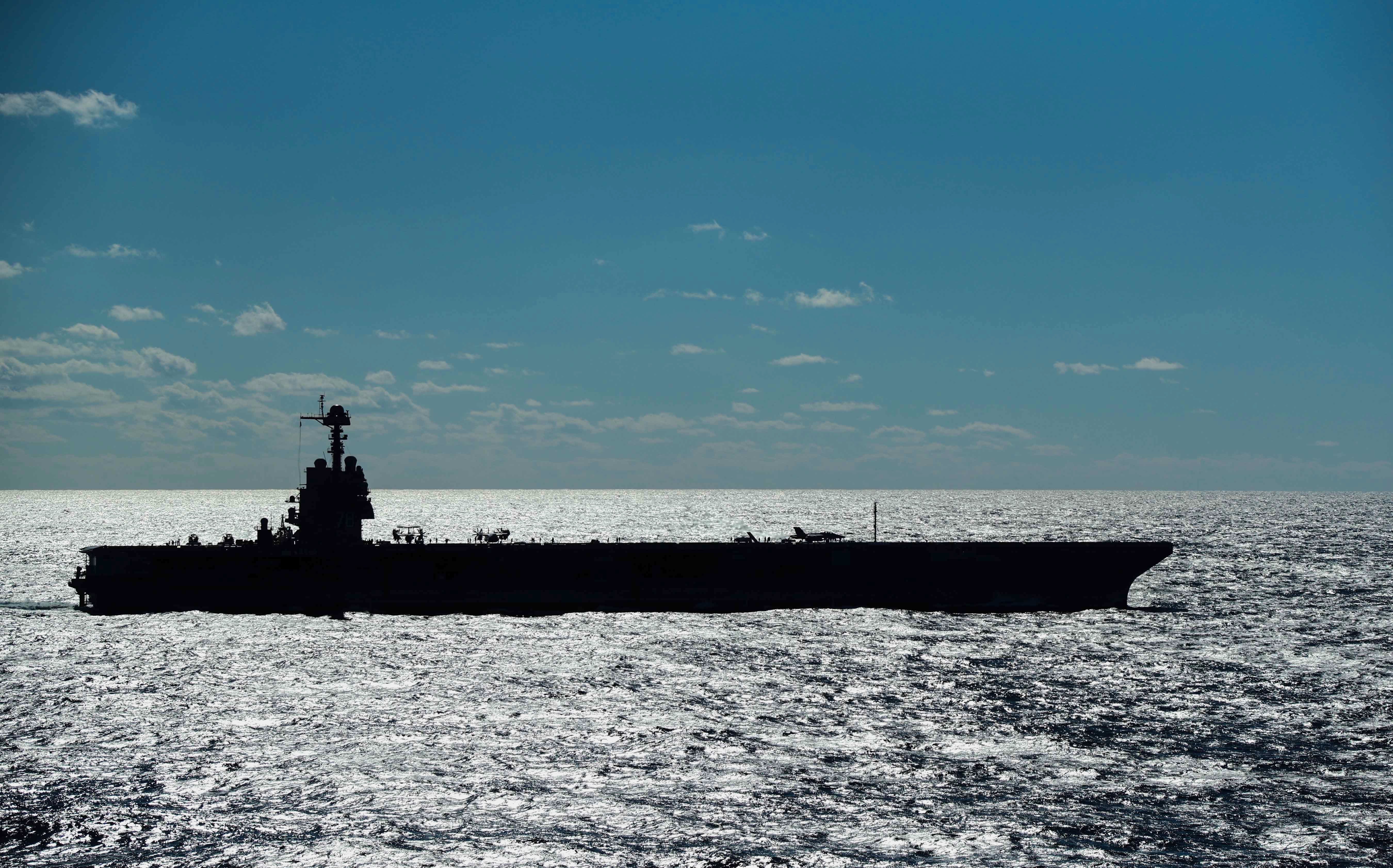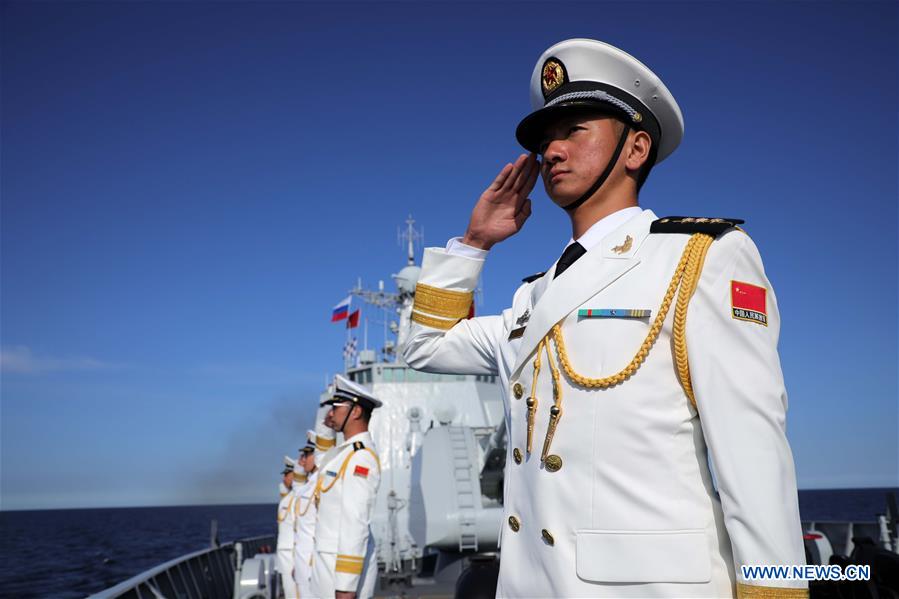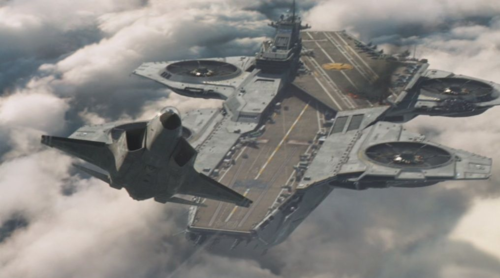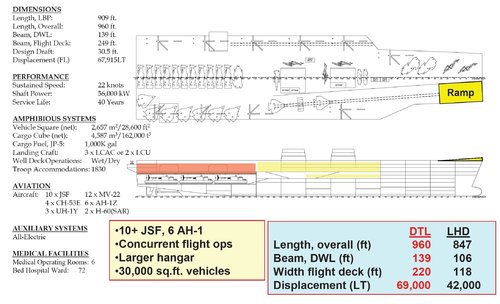Forest Green
ACCESS: Above Top Secret
- Joined
- 11 June 2019
- Messages
- 9,508
- Reaction score
- 17,401
Those are the second ships for those names.
Those are the second ships for those names.
Those are the second ships for those names.
CVN-80 will be the ninth ship (and third aircraft carrier) to bear the name USS Enterprise.
They were probably inspired by the CVN-65, which was the first nuclear-powered carrier and still the longest. Forgot about CV-6.Are you including the 6 Trek versions and the Shuttle?
They were probably inspired by the CVN-65, which was the first nuclear-powered carrier and still the longest. Forgot about CV-6.
General Atomics Electromagnetic Systems (GA-EMS) announced that High Cycle Testing of its Advanced Arresting Gear (AAG) system for Ford-class aircraft carriers was successfully completed over a two-day period in October 2019 at the Runway Arrested Landing Site (RALS) in Lakehurst.......
.....“Over and over again, in rapid succession, AAG sustained an aircraft arrestment rate of nearly one per minute successfully testing the system’s capability to handle the recovery sequence required for combat readiness"



Nuclear-powered flying carrier, that would render the DF-21D and DF-26 redundant.
Beyond The Ford: Navy Studies Next-Gen Carriers EXCLUSIVE - Breaking Defense
The Future Carrier 2030 Task Force, which the service will announce next week, will study how carriers stack up against new generations of stealthy submarines and long-range precision weapons being fielded by China and Russia.breakingdefense.com

They were probably inspired by the CVN-65, which was the first nuclear-powered carrier and still the longest. Forgot about CV-6.
The Enterprise in TOS was (they also had the Constellation). The Shuttle was inspired by Star Trek. I would not be at all surprised if CVN-80 was not also inspired by Star Trek. There was a write-in effort there. https://www.freewebs.com/jeffhead/cvn80-bige/

Beyond The Ford: Navy Studies Next-Gen Carriers EXCLUSIVE - Breaking Defense
The Future Carrier 2030 Task Force, which the service will announce next week, will study how carriers stack up against new generations of stealthy submarines and long-range precision weapons being fielded by China and Russia.breakingdefense.com
I think I've come around to the CSBA idea of replacing the LHD/As, as they retire, with a medium carrier. They can be "lightning carriers," ASW carriers, or assault carriers as needed while definitively jettisoning the well deck roles.
Only if it's not at the expense of CVNs.I think I've come around to the CSBA idea of replacing the LHD/As, as they retire, with a medium carrier. They can be "lightning carriers," ASW carriers, or assault carriers as needed while definitively jettisoning the well deck roles.
Oh for the proposed AEW and ASW variants of the CL-84 tiltwing.I think I've come around to the CSBA idea of replacing the LHD/As, as they retire, with a medium carrier. They can be "lightning carriers," ASW carriers, or assault carriers as needed while definitively jettisoning the well deck roles.
Didn't they mainly propose just redesignating the LHA(R)s as CVEs? Without a pretty expensive VSTOL aircraft development program, they'd be awfully limited.
Is that really new? Sounds like reinventing the NATO Atlantic reinforcement mission to me.
A small carrier with a capability to carry 24 MV-22 and 24 F-35B and 12-24 smaller AH-1/MH-60/FVL helicopters would indeed be a useful aircraft carrier to support the more conventional well deck equipped amphibious ships. This would be the ideal aerial assault platform for the USMC, but the rub is removing the well deck makes this a pure aircraft carrier and it would be more difficult to get political approval even if it lacked cats and traps like a CVN. The end result would be something very similar in size to the Queen Elizabeth-class, a not inconsiderable size and cost.
In their report it was not, they had CVNs and "CVLs" (not my preferred designation) 1:1.Only if it's not at the expense of CVNs.I think I've come around to the CSBA idea of replacing the LHD/As, as they retire, with a medium carrier. They can be "lightning carriers," ASW carriers, or assault carriers as needed while definitively jettisoning the well deck roles.
No, their plan was ultimately to produce a conventional medium carrier. There would be a transition as the existing LHAs were used more extensively in the "lightning carrier" role. But they were aiming for an angled flight deck and catapults on something slightly smaller than the brits' CVF, or similar to a fully modernized Midway. The Marines' STOVL F-35s and Navy/Marine CATOBAR F-35s could operate alongside each other in an air wing.I think I've come around to the CSBA idea of replacing the LHD/As, as they retire, with a medium carrier. They can be "lightning carriers," ASW carriers, or assault carriers as needed while definitively jettisoning the well deck roles.
Didn't they mainly propose just redesignating the LHA(R)s as CVEs? Without a pretty expensive VSTOL aircraft development program, they'd be awfully limited.
No, their plan was ultimately to produce a conventional medium carrier. There would be a transition as the existing LHAs were used more extensively in the "lightning carrier" role. But they were aiming for an angled flight deck and catapults on something slightly smaller than the brits' CVF, or similar to a fully modernized Midway. The Marines' STOVL F-35s and Navy/Marine CATOBAR F-35s could operate alongside each other in an air wing.I think I've come around to the CSBA idea of replacing the LHD/As, as they retire, with a medium carrier. They can be "lightning carriers," ASW carriers, or assault carriers as needed while definitively jettisoning the well deck roles.
Didn't they mainly propose just redesignating the LHA(R)s as CVEs? Without a pretty expensive VSTOL aircraft development program, they'd be awfully limited.
..would second the "57,000 ton missile and rocket' ship (just would add Gun to thatNo, their plan was ultimately to produce a conventional medium carrier. There would be a transition as the existing LHAs were used more extensively in the "lightning carrier" role. But they were aiming for an angled flight deck and catapults on something slightly smaller than the brits' CVF, or similar to a fully modernized Midway. The Marines' STOVL F-35s and Navy/Marine CATOBAR F-35s could operate alongside each other in an air wing.I think I've come around to the CSBA idea of replacing the LHD/As, as they retire, with a medium carrier. They can be "lightning carriers," ASW carriers, or assault carriers as needed while definitively jettisoning the well deck roles.
Didn't they mainly propose just redesignating the LHA(R)s as CVEs? Without a pretty expensive VSTOL aircraft development program, they'd be awfully limited.
Ok. I came across the synopsis of a 2005 proposal that has the redesignation bit.
I'm talking about the politicians doing so, not the USN.In their report it was not, they had CVNs and "CVLs" (not my preferred designation) 1:1.Only if it's not at the expense of CVNs.I think I've come around to the CSBA idea of replacing the LHD/As, as they retire, with a medium carrier. They can be "lightning carriers," ASW carriers, or assault carriers as needed while definitively jettisoning the well deck roles.
Ah, that's the LHA(R) when the dual tramline concept was still in the running before they went safe with the America. Which given the Navy's recent track record with going for broke may have been wise. Still, that would make a terrific CVE even with the dock. Take the Dock out and add hangar space and you could be looking at 40+ aircraft, at which point an EV-22 AEW would be a virtual necessity.Ok. I came across the synopsis of a 2005 proposal that has the redesignation bit.
 Although seeing as the dual tramline is about the same size as a QE2, and those are around $4 billion each, it would be easier to build QE2s as CVEs or, given how CVEs were used in WW2, CVMs (for multirole). That dual tramline really is a nice looking design though.
Although seeing as the dual tramline is about the same size as a QE2, and those are around $4 billion each, it would be easier to build QE2s as CVEs or, given how CVEs were used in WW2, CVMs (for multirole). That dual tramline really is a nice looking design though.I must admit I get confused by modern CVN airgroups. Back in the Cold War they justified these huge platforms with long range air defence (F14s) strike(A6s) ASW(S3s) and AEW/COD (E and C2). Now its a bunch of F35s and helos which could almost fly off the old Ark Royal. Looking further ahead, UAVs could be operated and recovered in various ways. Helos can stay on LHAs LHDs or whatever.
That seems too big, honestly. Either 24 V-22 or 24 F-35 (not sure those are equivalent deck spots but you get the idea).
Politically, we did buy a pair of LHA(R) without well decks. And it wasn't really great for the Marines because it makes it really hard for a three-ship ARG to work without those extra dock spaces. But if you don't care about MEU floats, it can have advantages (and MEUs aren't getting the workout they used to get so maybe it's not such a key capability). If they do add something like the stern-landing ships they're talking about (basically modern LSMs) that might replace the well on big decks.
I must admit I get confused by modern CVN airgroups. Back in the Cold War they justified these huge platforms with long range air defence (F14s) strike(A6s) ASW(S3s) and AEW/COD (E and C2). Now its a bunch of F35s and helos which could almost fly off the old Ark Royal. Looking further ahead, UAVs could be operated and recovered in various ways. Helos can stay on LHAs LHDs or whatever.
I must admit I get confused by modern CVN airgroups. Back in the Cold War they justified these huge platforms with long range air defence (F14s) strike(A6s) ASW(S3s) and AEW/COD (E and C2). Now its a bunch of F35s and helos which could almost fly off the old Ark Royal. Looking further ahead, UAVs could be operated and recovered in various ways. Helos can stay on LHAs LHDs or whatever.
There are varied reasons to this. In the USN case, the Super Hornet and F-35 replaced, for the sake of cost savings, aircraft with superior performances than themselves - Tomcat and A-6, notably. F-35 continued the SH downward spiral, although it also brings different capabilities that may compensate the lower "raw" performance, I mean speed and range.
As for the number of platforms on carrier decks, it surely shrunk since 1985 when there were Tomcat and A-6 and A-7 and Vikings and Hornets on the decks, plus support aircraft like KA-3s. Unlike the above it is not necessarily a bad trend overall. The least number of different airframes, the least expensive the CAG, sure.
But in the case of the SH and F-35 it went a little too far. The most spectacular area is long range strike from carriers, where the antiquated A-6 range still isn't matched by its successors. 23 years after the type retirement, in 1997.
That ackward moment when you realize the USN amphibs have reached such a huge size and tonnage (equalling the Charles de Gaulle or even beyond) the USN has the ultimate luxury of
a) turning the current amphibs into surrogate light carriers using the VSTOL variant of the F-35
b) even better, creating a brand new class of light carriers out of their hulls (*light* being all relative, in the sense of USS Gerald Ford 100 000 tons, 45000 tons is *light* - although it already matches or even dwarf Essex, Clems, Hermes, and very nearly Midways...)
Will this be the *revenge of the CVV* ? back then the USN could argue building them out of thin air was too expensive, plus they encroached on Midway or Forrestal areas.
Nowadays however, Nimitz and Ford have balooned to such tonnages, and amphibs, too... basically a reborn CVV could very nearly being build out of the present amphibs while remaining small enough not to *bother* the Nimitz and Fords in overall capability... and cost.
Makes one think.
65000 tons for a Forrestal, 80 000 tons+ for a Nimitz, nearly 100 000 tons for a Ford. If that's not weight balloning... !!!That ackward moment when you realize the USN amphibs have reached such a huge size and tonnage (equalling the Charles de Gaulle or even beyond) the USN has the ultimate luxury of
a) turning the current amphibs into surrogate light carriers using the VSTOL variant of the F-35
b) even better, creating a brand new class of light carriers out of their hulls (*light* being all relative, in the sense of USS Gerald Ford 100 000 tons, 45000 tons is *light* - although it already matches or even dwarf Essex, Clems, Hermes, and very nearly Midways...)
Will this be the *revenge of the CVV* ? back then the USN could argue building them out of thin air was too expensive, plus they encroached on Midway or Forrestal areas.
Nowadays however, Nimitz and Ford have balooned to such tonnages, and amphibs, too... basically a reborn CVV could very nearly being build out of the present amphibs while remaining small enough not to *bother* the Nimitz and Fords in overall capability... and cost.
Makes one think.
"Nowadays"? Supercarriers have been around for over half a century.
More like 80,000-82,000 full load for Forrestals65000 tons for a Forrestal, 80 000 tons+ for a Nimitz, nearly 100 000 tons for a Ford. If that's not weight balloning... !!!That ackward moment when you realize the USN amphibs have reached such a huge size and tonnage (equalling the Charles de Gaulle or even beyond) the USN has the ultimate luxury of
a) turning the current amphibs into surrogate light carriers using the VSTOL variant of the F-35
b) even better, creating a brand new class of light carriers out of their hulls (*light* being all relative, in the sense of USS Gerald Ford 100 000 tons, 45000 tons is *light* - although it already matches or even dwarf Essex, Clems, Hermes, and very nearly Midways...)
Will this be the *revenge of the CVV* ? back then the USN could argue building them out of thin air was too expensive, plus they encroached on Midway or Forrestal areas.
Nowadays however, Nimitz and Ford have balooned to such tonnages, and amphibs, too... basically a reborn CVV could very nearly being build out of the present amphibs while remaining small enough not to *bother* the Nimitz and Fords in overall capability... and cost.
Makes one think.
"Nowadays"? Supercarriers have been around for over half a century.
This is the study I was referring to [PDF warning] for reference/comparison. I was wrong, btw, they actually have 12 CVNs and 10 "CVLs"No, their plan was ultimately to produce a conventional medium carrier. There would be a transition as the existing LHAs were used more extensively in the "lightning carrier" role. But they were aiming for an angled flight deck and catapults on something slightly smaller than the brits' CVF, or similar to a fully modernized Midway. The Marines' STOVL F-35s and Navy/Marine CATOBAR F-35s could operate alongside each other in an air wing.I think I've come around to the CSBA idea of replacing the LHD/As, as they retire, with a medium carrier. They can be "lightning carriers," ASW carriers, or assault carriers as needed while definitively jettisoning the well deck roles.
Didn't they mainly propose just redesignating the LHA(R)s as CVEs? Without a pretty expensive VSTOL aircraft development program, they'd be awfully limited.
Ok. I came across the synopsis of a 2005 proposal that has the redesignation bit.
The 4-ship ARG would consist of a CVL, an LPD, and two LX(R)s. The CVL would initially be a
legacy LHA/LHD but would eventually be replaced by a purpose-built 40,000- to 60,000-ton
CVL with catapults and arresting gear. The CVL would carry twenty to thirty primarily fixed-wing
aircraft to exploit the stealth and C4ISR (Command, Control, Communications, Computers,
Intelligence, Surveillance, and Reconnaissance) capability of the F-35B. The rotary-wing
aircraft displaced from the LHA/LHD would go to a small-deck amphibious ship (LPD or LX(R))
added to the current 3-ship ARG. The CVL air wing would focus on SUW, strike, and CAS
missions. The LPDs and LX(R)s would conduct SUW as well as amphibious operations using
their attack helicopters and the long-range surface-to-surface missiles in VLS magazines. With
a VLS magazine, small-deck amphibious ships would also be able to employ medium-range air
defense interceptors such as ESSM to improve their staying power in a contested area.
The proposed fleet architecture adds to today’s CVNs smaller conventionally powered CVLs of 40,000 to 60,000 tons that would be incorporated into ARGs as part of the Deterrence Force. CVLs would provide power projection and sea control capabilities at the scale needed for day-to-day operations and for SUW, strike, and CAS as part of initial combat, freeing CVNs to focus on high-end integrated multi-carrier operations as part of the Maneuver Force or the Northern Europe Deterrence Force.
In the near-term, existing LHA/LHD amphibious assault ships would be employed as CVLs using a loadout of twenty to twenty-five F-35B aircraft.67 As they reach the end of their service life, LHA/LHD-derived CVLs would be replaced by purpose-built CVLs with a displacement similar to a Cold War-era Midway-class aircraft carrier and equipped with catapults and arresting gear.68 As a result, CVL air wings would be able to become slightly larger and incorporate airborne electronic attack (AEA) and airborne early warning (AEW) aircraft that are catapult-launched and require an arrested landing.
That ackward moment when you realize the USN amphibs have reached such a huge size and tonnage (equalling the Charles de Gaulle or even beyond) the USN has the ultimate luxury of
a) turning the current amphibs into surrogate light carriers using the VSTOL variant of the F-35
b) even better, creating a brand new class of light carriers out of their hulls (*light* being all relative, in the sense of USS Gerald Ford 100 000 tons, 45000 tons is *light* - although it already matches or even dwarf Essex, Clems, Hermes, and very nearly Midways...)
Will this be the *revenge of the CVV* ? back then the USN could argue building them out of thin air was too expensive, plus they encroached on Midway or Forrestal areas.
Nowadays however, Nimitz and Ford have balooned to such tonnages, and amphibs, too... basically a reborn CVV could very nearly being build out of the present amphibs while remaining small enough not to *bother* the Nimitz and Fords in overall capability... and cost.
Makes one think.
Full load displacement on commissioning, data for the first three carriers from various editions of Jane's Fighting Ships:More like 80,000-82,000 full load for Forrestals
81,000 - 84,000 for Kitty Hawks/JFK
95,000 for Enterprise (CVN-65)
100,000-104,000 for Nimitz class. About the same for Ford.
ALL are considered "supercarriers".
This is the study I was referring to [PDF warning] for reference/comparison. I was wrong, btw, they actually have 12 CVNs and 10 "CVLs"
The 4-ship ARG would consist of a CVL, an LPD, and two LX(R)s. The CVL would initially be a
legacy LHA/LHD but would eventually be replaced by a purpose-built 40,000- to 60,000-ton
CVL with catapults and arresting gear. The CVL would carry twenty to thirty primarily fixed-wing
aircraft to exploit the stealth and C4ISR (Command, Control, Communications, Computers,
Intelligence, Surveillance, and Reconnaissance) capability of the F-35B. The rotary-wing
aircraft displaced from the LHA/LHD would go to a small-deck amphibious ship (LPD or LX(R))
added to the current 3-ship ARG. The CVL air wing would focus on SUW, strike, and CAS
missions. The LPDs and LX(R)s would conduct SUW as well as amphibious operations using
their attack helicopters and the long-range surface-to-surface missiles in VLS magazines. With
a VLS magazine, small-deck amphibious ships would also be able to employ medium-range air
defense interceptors such as ESSM to improve their staying power in a contested area.The proposed fleet architecture adds to today’s CVNs smaller conventionally powered CVLs of 40,000 to 60,000 tons that would be incorporated into ARGs as part of the Deterrence Force. CVLs would provide power projection and sea control capabilities at the scale needed for day-to-day operations and for SUW, strike, and CAS as part of initial combat, freeing CVNs to focus on high-end integrated multi-carrier operations as part of the Maneuver Force or the Northern Europe Deterrence Force.
